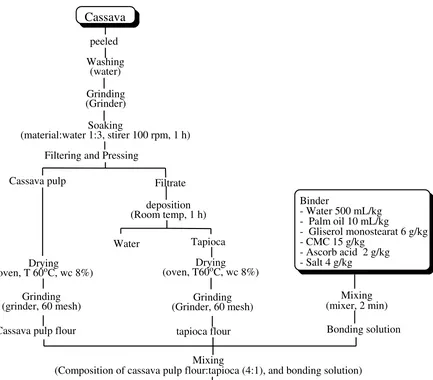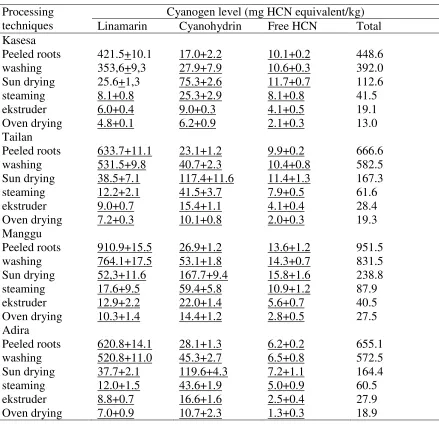The effects of processing techniques against cyanogen levels during the
production of siger rice from cassava (
Manihot esculenta
)
Subeki1, Wisnu Satyajaya1, Tanto Pratondo Utomo1, dan Muhartono2
1
Department of Agricultural Product Technology, Faculty of Agriculture, Lampung University. Jl. S. Brojonegoro No. 1 Bandar Lampung – Lampung 34145
2
Department of Medicinal Education, Faculty of Medicine, Lampung University. Jl. S. Brojonegoro No. 1 Bandar Lampung – Lampung 34145
Email: [email protected]
Abstract
This study investigated the effects of cassava processing techniques against cyanogen levels to low levels during the production of siger rice from cassava (Manihot esculenta). The processing techniques used for step each of siger rice production were
vary in details from one processor to the other. They were highly effective in substantially reducing mean cyanogen levels (76,24-88,26 mg/kg) to low levels (0,45-2,72 mg/kg). In spite of the different cassava varieties used for processing, similar mean reduction levels (96.2–99.5%) in cyanogens levels were obtained by the processors 96,92%, 97,50%, 99,41%, and 98,16% for Kasesa, Tailan, Manggu, and Adira, respectively. Siger rice made from cassava variety of Kasesa produces white color, sticky texture, preferably by panelists, containing moisture content (9.81%), ash (0.47%), fat (0.90%), Protein (2.13%), crude fiber (4.79%), carbohydrate (81.90%), and glycemic index 31.
Keywords: cyanogen, Manihot esculenta, processing techniques, ubikayu
I. Introduction
Cassava (Manihot esculenta Crantz) is a widely grown plant in the tropics and a
dependent upon pH and temperature, with stability increasing at acidic pH values (Cooke, 1978). Acetone cyanohydrin can also be broken down by an enzyme hydroxynitrile lyase, which has been found mainly in leaves but with little activity in roots (White et al., 1998).
It is widely claimed that there is inter- and intracommunal variability in cassava processing techniques due to a clear lack of standardization (NRI, 1989; Nweke, 1994) that has been reported to produce foods with variable organoleptic properties and different levels of residual cyanohydrin and HCN (Banea et al.,1992). These residual compounds have been incriminated for the toxicity associated with the continued ingestion of insufficiently processed cassava (Mlingi et al., 1992; Tylleska, 1994). Cassava toxicity has been reported to occur when food shortage and social instability induces shortcuts in established processing methods or when high cyanogen varieties are introduced into areas lacking appropriate processing techniques (Bokanga et al., 1994).
Despite the importance of cassava as a staple food, there is limited information on the effectiveness of different processing techniques in reducing total cyanogens contents of a wide range of cassava varieties to low levels. Some studies have partly elucidated the variations in total cyanogens during cassava fermentation and soaking processes used in the production of a few foods while exempting the other stages in the overall production chain (Westby, 1991; O’Brien et al., 1992; Oyewole and Odunfa, 1992; Brauman et al., 1995). The effectiveness of processing techniques is essential if cassava foods are to be produced on a large scale and in case the techniques have to be modified and/or improved without causing adverse effects to health.
prediction error variance and to find out if any differences between treatments. The results from anova were then analyzed using least significant different (LSD) at 5% level.
2.2. Siger Rice production
Cassava
2.3. Chemical analyses
Each of the process batches was analysed in quadruplicate. Moisture content was determined by the AOAC (1990) method while pH values were measured using a combination electrode on a sample (10 g) homogenized with distilled water (100 ml). Extraction and assay of cyanogens (linamarin, cyanohydrin and HCN) was by the Cooke (1978, 1979) method as modified by O’Brien et al. (1991).
III. Results and discussion
3.1. Initial cyanogen contents
The mean total cyanogen contents of the cassava roots, expressed on a dry weight basis, ranged from 197.3 mg HCN equivalent/kg in adira to 951.5 mg HCN equivalent/kg in var. of tailan (Table 1). Virtually, the major cyanogen found in the roots was in the form of linamarin and a certain amount of enzymic hydrolysis had occurred during the rapid preparation of samples for chemical analyses, which resulted in small quantities of cyanohydrin and free HCN. Throughout this study, it was observed that HCN represented only a small proportion of total cyanogens.
3.2. Effects of processing techniques
Table 1. Variations in cyanogens levels during cassava processing for the production of siger rice
Processing techniques
Cyanogen level (mg HCN equivalent/kg) Linamarin Cyanohydrin Free HCN Total Kasesa
Peeled roots 421.5+10.1 17.0+2.2 10.1+0.2 448.6
washing 353,6+9,3 27.9+7.9 10.6+0.3 392.0
Sun drying 25.6+1,3 75.3+2.6 11.7+0.7 112.6
steaming 8.1+0.8 25.3+2.9 8.1+0.8 41.5
ekstruder 6.0+0.4 9.0+0.3 4.1+0.5 19.1
Oven drying 4.8+0.1 6.2+0.9 2.1+0.3 13.0
Tailan
Peeled roots 633.7+11.1 23.1+1.2 9.9+0.2 666.6
washing 531.5+9.8 40.7+2.3 10.4+0.8 582.5
Sun drying 38.5+7.1 117.4+11.6 11.4+1.3 167.3
steaming 12.2+2.1 41.5+3.7 7.9+0.5 61.6
ekstruder 9.0+0.7 15.4+1.1 4.1+0.4 28.4
Oven drying 7.2+0.3 10.1+0.8 2.0+0.3 19.3
Manggu
Peeled roots 910.9+15.5 26.9+1.2 13.6+1.2 951.5
washing 764.1+17.5 53.1+1.8 14.3+0.7 831.5
Sun drying 52,3+11.6 167.7+9.4 15.8+1.6 238.8
steaming 17.6+9.5 59.4+5.8 10.9+1.2 87.9
ekstruder 12.9+2.2 22.0+1.4 5.6+0.7 40.5
Oven drying 10.3+1.4 14.4+1.2 2.8+0.5 27.5
Adira
Peeled roots 620.8+14.1 28.1+1.3 6.2+0.2 655.1
washing 520.8+11.0 45.3+2.7 6.5+0.8 572.5
Sun drying 37.7+2.1 119.6+4.3 7.2+1.1 164.4
steaming 12.0+1.5 43.6+1.9 5.0+0.9 60.5
ekstruder 8.8+0.7 16.6+1.6 2.5+0.4 27.9
marginally more evident for siger rice production than for the other foods. This could be due to the smaller root sizes obtained after grating during siger rice production as compared to chunks (1–4 cm) and (5–9 cm) soaked in water, respectively, for the production of siger rice production. With regard to the greatest reduction in cyanogens, the most important techniques used in the production of the foods studied were those that maximise cassava root tissue disintegration. Grating, cutting and soaking in water cause tissue cellular disruption that results in comparatively greater susceptibility to the actions of bacteria, as indicated by the fall in pH values, and the enzymes a-amylase and
endogenous linamarase (Cooke, 1979).
Root softening during soaking has been ascribed to an increase in the activity of cell-wall degrading enzymes (Okolie and Ugochukwu, 1998; Ampe et al., 1995). It has been reported that the rate of acidification increased with decreasing cassava root sizes (id. o15 mm) during the first 48 h of fermentation for the production of siger rice which
also affected product organoleptic qualities. The reduction in cyanogen levels has been found to be strongly correlated to the degree of root size reduction, which is also directly related to the rate of softening and acidification (O’Brien et al., 1992; Ampe et al., 1994; Westby and Choo, 1994). From this study, it could be deduced that the efficacy of root size reduction and the level of endogenous linamarase activity are important factors in the effectiveness of linamarin elimination.
IV. Conclusion
Acknowledgements
Kemenristek DIKTI provided funding 2017 for this study. We acknowledge the pleasant collaboration of the cassava processors during our scientific study.
References
Agbor Egbe, T., Brauman, A., Griffon, B., Poulter, N., Tre` che, S., 1995. Glossaire e´ le´ mentaire de la transformation du manoic/Basic glossary on cassava processing. In: Agbor Egbe, T., Brauman, A., Griffon, D., Tre` che, S. (Eds.), Transformation Alimentaire du Manioc/Cassava Food Processing. ORSTOM Editions, Collection Colloques et Se´ minaires, pp. 725–738.
Ampe, F., Brauman, A., Tre` che, S., Agossou, A., 1994. Cassava retting: Optimisation of village fermentation by an experimental research methodology. Journal of the Science of Food and Agriculture 65, 355–361.
Ampe, F., Ke´ le´ ke´ , S., Robert, H., Brauman, A., 1995. The role and origin of pectin degrading enzymes during cassava retting. In: Agbor Egbe, T., Brauman, A., Griffon, D., Tre` che, S. (Eds.), Transformation Alimentaire du Manioc/Cassava Food Processing. ORSTOM Editions, Collection Colloques et Se´ minaires, pp. 331–344.
Association of Official Analytical Chemists, 1990. , 15th ed. Official Methods of Analysis, vol. II. Association of Official Analytical Chemists, Washington, DC. Banea, M., Poulter, N.H., Rosling, H., 1992. Short cuts in cassava processing and risks of
dietary cyanide exposure in Zaire. Food and Nutrition Bulletin 14 (2), 137–143. Bokanga, M., Essers, A.J.A., Poulter, N.H., Rosling, H., Tewe, O., 1994. International
Workshop on Cassava Safety. Ibadan, Nigeria. 1–4 March 1994. Acta Horti 375, 11–119.
Brauman, A., Ke´ le´ ke´ , S., Mavoungou, O., Ampe, F., Miambi, E., 1995. Etude du cine´ tique du rouissage traditionnel des racines du manioc en Afrique Centrale (Congo). In: Agbor Egbe, T., Brauman, A., Griffon, D., Tre` che, S. (Eds.), Transformation Alimentaire du Manioc/Cassava Food Processing. ORSTOM Editions, Collection Colloques et Se´ minaires, pp. 287–305.
Cooke, R.D., 1978. An enzymatic assay for the total cyanide content of cassava (Manihot esculenta Crantz). Journal of the Science of Food and Agriculture 29, 345–352. Cooke, R.D., 1979. Enzymatic assay for determining the cyanide content of cassava and
Nweke, F.I., 1994. Processing potentials for cassava production growth. COSCA Working Paper No. 11, Collaborative Study of Cassava in Africa, IITA, Ibadan, Nigeria.
Nweke, F.I., Dixon, A.G.O., Assiedu, R., Folayan, S.A., 1994. Cassava varietal needs of farmers and potentials for production growth in sub-Saharan Africa. COSCA Working Paper No. 10, Collaborative Study of Cassava in Africa, IITA, Ibadan, Nigeria.
O’Brien, G.M., Taylor, A.J., Poulter, N.H., 1991. Improved enzymic assay for cyanogens in fresh and processed cassava. Journal of the Science of Food and Agriculture 56, 277–289.
O’Brien, G.M., Mbome, L., Taylor, A.J., Poulter, N.H., 1992. Variations in cyanogen content of casssava during village processing in Cameroon. Food Chemistry 44, 131–136.
Okafor, N., Ejiofor, M.A.N., 1986. The microbial breakdown of linamarin in fermenting pulp of cassava (Manihot esculenta Crantz). MIRCEN Journal 2, 327–338.
Okafor, N., Ijioma, B., Oyolu, C., 1984. Studies on the microbiology of cassava retting for foo foo production. Journal of Applied Bacteriology 56, 277–289.
Okolie, P.N., Ugochukwu, E.N., 1998. Changes in activities of cell wall degrading enzymes during fermentation of cassava (Manihot esculenta Crantz). Journal of the Science of Food and Agriculure 4, 51–61.
Oyewole, O.B., 1994. Upgrading village cassava fermentation through process improvement. In: Ofori, F., Hahn, S.K. (Eds.), Tropical Root Crops in a Developing Economy. Proceedings of the 9th Symposium of the International Society for Tropical Root Crops, 20–26 October 1991, Accra, Ghana, pp. 226– 261.
Oyewole, O.B., Odunfa, S.A., 1990. Characterisation and distribution of lactic acid bacteria in cassava fermentation during ‘‘fufu’’ production. Journal of Applied Bacteriology 68, 145–152.
Oyewole, O.B., Odunfa, S.A., 1992. Effects of processing variables on cassava fermentation for ‘‘fufu’’ production. Tropical Science 32, 231–240.
Tylleska¨ r, T., 1994. The association between cassava and the paralytic disease konzo. Acta Horticulture 375, 321–331.
Vasconcelos, A.T., Twiddy, D.R., Westby, A., Reilly, P.J.A., 1990. Detoxification of cassava during gari preparation. International Journal of Food Science and Technology 25, 198–203.
Westby, A., 1991. Strategies for research into the mechanisms of cyanide reduction during the fermentation of cassava. Food Laboratory News 7 (2), 24–28.
Westby, A., 2002. Cassava utilisation, storage and small-scale processing. In: Hillcocks, R.J., Thresh, J.M., Bellotti, A.C. (Eds.), Cassava: Biology, Production and Utilization. CAB International, pp. 281–300 Chapter 14.
Westby, A., Choo, B.K., 1994. Cyanogen reduction during the lactic fermentation of cassava. Acta Horticulture 375, 209–215.

